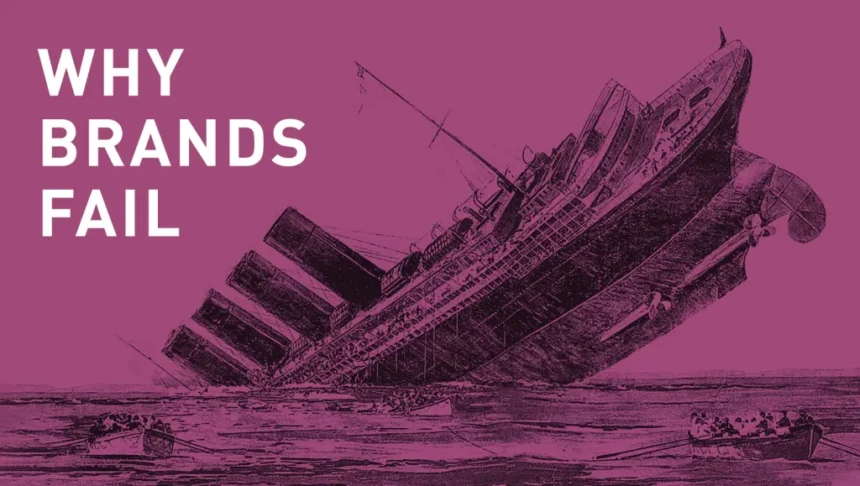…The Truth About the Biggest Brand Mistakes of All Time
Matt Haig, a writer, journalist, and marketing professional, provides a deep dive into the reality of brand failures from a human emotional perspective. His approach aligns with Costica Bradatan’s In Praise of Failure, which frames failure as an enlightening lesson – something to be embraced rather than resisted. Haig suggests that brand failure stems from acts of omission or commission in the pursuit of success. Ironically, he posits that success itself makes failure more likely, as it inflates a brand’s ego.
Haig takes us on a historical journey, reminding us that branding was developed in the 1880s as a means to protect products from failure. He describes branding as the infusion of human elements into a product, transforming marketing into a process of perception-building. However, this shift has made brands vulnerable – because consumers make decisions based on perception rather than the reality of the product. This means that while brands can attain immense value beyond their physical assets, they can also lose that value overnight. In today’s world, perception is reality, and reality is perception.
The Emotional Connection to Brands
Much like human relationships, customers become emotionally attached not only to products but also to the rewards they receive from them. They develop loyalty based on certain expectations and values. However, a single marketing blunder can shatter that trust. The modern marketplace is fiercely competitive, and a failure to align with consumer expectations can have devastating consequences.
In the past, a product’s quality determined a company’s fate, but today, branding takes center stage. As Al and Laura Ries noted in The 22 Immutable Laws of Branding, branding “pre-sells” a product or service to consumers. A strong brand can elevate a mediocre product, but poor branding can doom even the best offerings. This heightens both the rewards and risks associated with branding. Since emotions play a crucial role in consumer choices, Haig warns that brands must handle their relationships with customers delicately.
The Seven Deadly Sins of Branding: Brand Amnesia
Haig identifies seven key reasons brands fail, which he dubs the “seven deadly sins of branding.” The first and most fundamental is Brand Amnesia – a failure to remember what the brand stands for. Older brands, like aging individuals, may struggle with memory loss. In an attempt to innovate or refresh their image, brands may stray too far from their core identity. This can lead to brand erosion, which might go unnoticed until it’s too late.
A classic example of this, according to Haig, is the infamous failure of New Coke. Coca-Cola’s decision to replace its flagship soft drink in 1985 with a new formula turned into a marketing disaster. The company believed consumers only cared about taste, but the backlash proved otherwise. Despite extensive taste tests showing that New Coke was preferred over both original Coke and Pepsi, the brand underestimated the emotional attachment consumers had to the original formula.
The public outrage and drop in sales forced Coca-Cola to reintroduce the original formula as Coca-Cola Classic, marking one of the biggest marketing blunders of all time. Coca-Cola had mistakenly placed product over perception, forgetting that branding is not just about what’s in the bottle but what the bottle represents to its customers. Donald Keough, Coca-Cola’s Chief Operating Officer at the time, later admitted:
“The simple fact is that all the time and money and skill poured into consumer research on the new Coca-Cola could not measure or reveal the deep and abiding emotional attachment to original Coca-Cola felt by so many people. The passion for original Coca-Cola – and that is the word for it, passion – was something that caught us by surprise. It is a wonderful American mystery, a lovely American enigma, and you cannot measure it any more than you can measure love, pride, or patriotism.”
Lessons for Modern Brands
The lesson here is clear: every brand must be conscious of its core identity, or it will face the harsh judgment of consumers. Take, for example, Kia Optima’s failed positioning in the Nigerian automobile market. Initially marketed as a luxury vehicle, its status collapsed when consumers realized it was a budget-friendly car, leading to misplaced expectations and a credibility crisis.
Similarly, Gala Sausage Roll, once known for its rich, beefy taste, has faced significant consumer dissatisfaction due to declining quality. The tough business environment in Nigeria may have contributed to this decline, but it is ultimately brand erosion that has caused consumer trust to wane. If UAC Foods wishes to restore Gala’s former glory, it must return to the brand promise that once made it a staple snack choice.
Haig’s analysis reveals that marketing is about much more than just the product – it’s about perception, emotion, and trust. Every brand must remember what it stands for and stay true to that identity, or risk losing consumer loyalty.
Brand failure isn’t always about having a bad product; sometimes, it’s simply about forgetting who you are.







